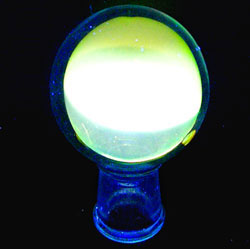| Posted: January 31, 2008 |
Nanocomposite solid-state lighting |
|
(Nanowerk News) Nanocrystal-based devices produce a higher quality white-light than current light sources and present an opportunity for higher efficiencies, say US scientists ("Encapsulated white-light CdSe nanocrystals as nanophosphors for solid-state lighting" – free access article).
|
|
Solid state lighting is the generation of light through the recombination of positive and negative carriers in a semiconducting material. The technology is synonymous with light emitting diodes (LEDs) and is likely to replace the inefficient lighting currently used in our businesses and homes. According to the US Department of Energy this could reduce the amount of energy needed for lighting in 2025 by as much as a third and lower carbon emission by 42 million tons per year in the US alone.
|
 |
|
However, the quality of the white light used in current LEDs is not adequate for every day use. Sandra Rosenthal and colleagues at Vanderbilt University, Nashville, US, approached this problem by developing a thermoplastic fluorocarbon polymer to encapsulate white-light emitting nanocrystals. 'This is the first major step towards making a viable phosphor LED,' said Michael Schreuder, one of the researchers in Rosenthal's group.
|
|
This encapsulation is essential to extend the longevity of these nanophosphors while keeping the high-quality white-light, allowing their use in commercial applications. The findings are very significant due the difficulty of finding an encapsulant that not only provides the protection necessary for a lighting device, but also does not reduce the quality of the light emitted from the nanocrystals. Nanocrystals have previously been encapsulated in other polymers, but they typically quench the nanocrystal luminescence or cause the nanocrystals to aggregate. Further, polymers often emit light of their own, which will modify the colour of light emitted.
|
|
Currently, the efficiency of this material is too low for a viable product and is not on par with commercially available LEDs. 'However, there is potential not only to maintain the high-quality white-light, but to surpass the efficiency of present-day devices,' says Schreuder.
|
|
In the future, Rosenthal hopes to increase the fluorescence efficiency of the nanocrystals while improving nanocrystal loading in the encapsulant by enhancing the nanocrystal-encapsulant interactions. One particular challenge is to maintain the high-quality white light produced while improving the fluorescence efficiency.
|

